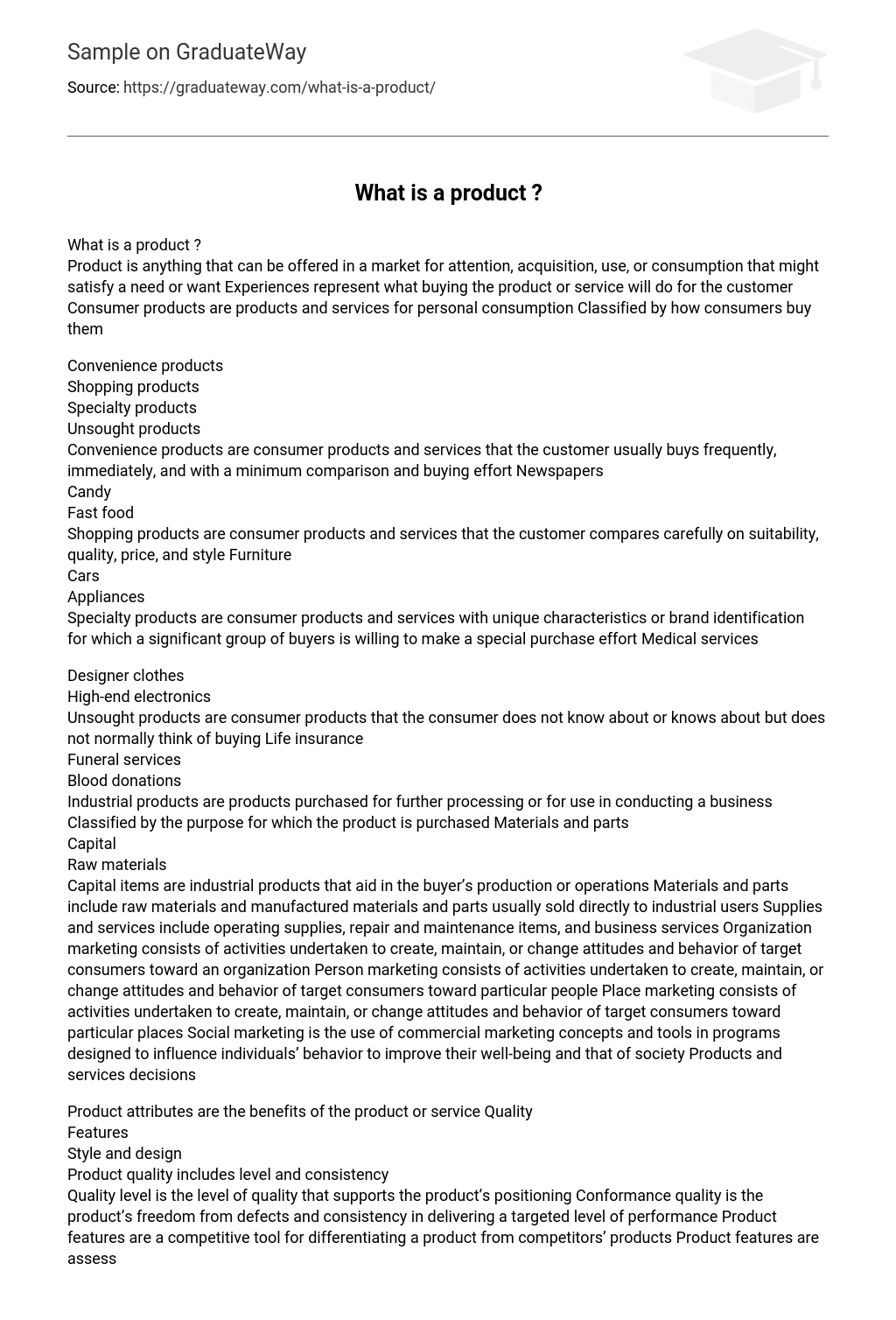Product is anything that can be offered in a market for attention, acquisition, use, or consumption that might satisfy a need or want Experiences represent what buying the product or service will do for the customer Consumer products are products and services for personal consumption. Classified by how consumers buy them:
- Convenience products
- Shopping products
- Specialty products
- Unsought products
Convenience products are consumer products and services that the customer usually buys frequently, immediately, and with a minimum comparison and buying effort:
- Newspapers
- Candy
- Fast food
Shopping products are consumer products and services that the customer compares carefully on suitability, quality, price, and style
- Furniture
- Cars
- Appliances
Specialty products are consumer products and services with unique characteristics or brand identification for which a significant group of buyers is willing to make a special purchase effort:
- Medical services
- Designer clothes
- High-end electronics
Unsought products are consumer products that the consumer does not know about or knows about but does not normally think of buying:
- Life insurance
- Funeral services
- Blood donations
Industrial products are products purchased for further processing or for use in conducting a business. Classified by the purpose for which the product is purchased
- Materials and parts
- Capital
- Raw materials
Capital items are industrial products that aid in the buyer’s production or operations. Materials and parts include raw materials and manufactured materials and parts usually sold directly to industrial users. Supplies and services include operating supplies, repair and maintenance items, and business services. Organization marketing consists of activities undertaken to create, maintain, or change attitudes and behavior of target consumers toward an organization. Person marketing consists of activities undertaken to create, maintain, or change attitudes and behavior of target consumers toward particular people. Place marketing consists of activities undertaken to create, maintain, or change attitudes and behavior of target consumers toward particular places. Social marketing is the use of commercial marketing concepts and tools in programs designed to influence individuals’ behavior to improve their well-being and that of society. Products and services decisions.
Product attributes are the benefits of the product or service
- Quality
- Features
- Style and design
- Product quality includes level and consistency
Quality level is the level of quality that supports the product’s positioning Conformance quality is the product’s freedom from defects and consistency in delivering a targeted level of performance. Product features are a competitive tool for differentiating a product from competitors’ products Product features are assessed based on the value to the customer versus the cost to the company. Style describes the appearance of the product.
Design contributes to a product’s usefulness as well as to its looks Brand is the name, term, sign, or design—or a combination of these—that identifies the maker or seller of a product or service. Brand equity is the differential effect that the brand name has on customer response to the product and its marketing. Packaging involves designing and producing the container or wrapper for a product Labels identify the product or brand, describe attributes, and provide promotion Products line decisions.
Product line is a group of products that are closely related because they function in a similar manner, are sold to the same customer groups, are marketed through the same types of outlets, or fall within given price ranges. Product line length is the number of items in the product line
- Line stretching
- Line filling
- Product Mix Decisions
Product mix consists of all the products and items that a particular seller offers for sale
- Width
- Length
- Depth
- Consistency
- Branding Strategy: Building Strong Brands
Brand represents the consumer’s perceptions and feelings about a product and its performance. It is the company’s promise to deliver a specific set of features, benefits, services, and experiences consistently to the buyers Brand Positioning.
Brand strategy decisions include:
- Product attributes
- Product benefits
- Product beliefs and values
- Brand name selection
Desirable qualities:
1. Suggest benefits and qualities
2. Easy to pronounce, recognize, and remember
3. Distinctive
4. Extendable
5. Translatable for the global economy
6. Capable of registration and legal protection
- Brand Sponsorship
- Manufacturer’s brand
- Private brand
- Licensed brand
- Co-brand
Services Marketing
- Government
- Private not-for-profit organizations
- Business services
Marketing Strategies for Service Firms
In addition to traditional marketing strategies, service firms often require additional strategies Service-profit chain.
- Internal marketing
- Interactive marketing
Service-profit chain links service firm profits with employee and customer satisfaction Internal service quality.
- Satisfied and productive service employees
- Greater service value
- Satisfied and loyal customers
- Healthy service profits and growth
Internal marketing means that the service firm must orient and motivate its customer contact employees and supporting service people to work as a team to provide customer satisfaction. Internal marketing must precede external marketing.
Interactive marketing means that service quality depends heavily on the quality of the buyer-seller interaction during the service encounter.
- Service differentiation
- Service quality
- Service productivity
Managing service differentiation creates a competitive advantage from the offer, delivery, and image of the service Offer can include distinctive features.
Delivery can include more able and reliable customer contact people, environment, or process Image can include symbols and branding.
Managing service quality provides a competitive advantage by delivering consistently higher quality than its competitors Service quality always varies depending on interactions between employees and customers. Managing service productivity refers to the cost side of marketing strategies for service firms Employee recruiting, hiring, and training strategies.





